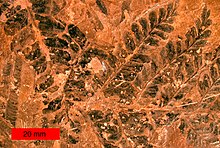Pteridospermatophyta
| Pteridospermatophyta | |
|---|---|

| |
| Fossil seed fern leaves of Neuropteris (Medullosales) from the Late Carboniferous of northeastern Ohio. | |

| |
| Life restoration of Lepidopteris (Peltaspermales) | |
| Scientific classification | |
| Kingdom: | Plantae |
| Clade: | Tracheophytes |
| Clade: | Spermatophytes |
| Division: | †Pteridospermatophyta |
| Groups included | |
| |
| Excluded | |
| |
| Synonyms | |
|
Pteridospermatopsida | |
Pteridospermatophyta, also called "pteridosperms" or "seed ferns" are a
With regard to the enduring utility of this
). This is particularly useful for extinct seed plant groups whose systematic relationships remain speculative, as they can be classified as pteridosperms with no valid implications being made as to their systematic affinities. Also, from a purely curatorial perspective the term pteridosperms is a useful shorthand for describing the fern-like fronds that were probably produced by seed plants, which are commonly found in many Palaeozoic and Mesozoic fossil floras.History of classification
The concept of pteridosperms goes back to the late 19th century when
Their discovery attracted considerable attention at the time, as the pteridosperms were the first extinct group of vascular plants to be identified solely from the fossil record. In the 19th century the Carboniferous Period was often referred to as the "Age of Ferns" but these discoveries during the first decade of the 20th century made it clear that the "Age of Pteridosperms" was perhaps a better description.
During the 20th century the concept of pteridosperms was expanded to include various Mesozoic groups of seed plants with fern-like fronds, such as the
It has been speculated that some seed fern groups may be close to the ancestry of
Taxonomy

Major groups
- Order †CalamopityalesNěmejc (1963)
- Order †CorystospermalesPetriella (1981) [= Umkomasiales Doweld (2001)]
- Order †Callistophytales Rothwell (1981) emend. Anderson, Anderson & Cleal (2007) [Poroxylales Němejc (1968)]
- Order †Petriellales Taylor et al. (1994)
- Order †Peltaspermales Taylor (1981) [Lepidopteridales Němejc (1968)]
- Order †GigantopteridalesLi & Yao (1983) [Gigantonomiales Meyen (1987)]
- Order †Pentoxylales Pilger & Melchior (1954)
- Order †Glossopteridales Plumstead, 1956
- Order †Caytoniales Gothan (1932)
- Order †Medullosales Corsin (1960)
- Order †Lyginopteridales (Corsin (1960)) Havlena (1961) [Lagenostomatales Seward ex Long (1975); Lyginodendrales Nemejc (1968); Sphenopteridales Schimper 1869]
- Family †Angaranthaceae Naugolnykh (2012)
- Family †Heterangiaceae Němejc (1950) nom. nud.
- Family †Physostomataceae Long (1975)
- Family †Lyginopteridaceae Potonie (1900) emend. Anderson, Anderson & Cleal (2007) [Lagenostomataceae Long (1975; Pityaceae Scott (1909); Lyginodendraceae Scott (1909); Sphenopteridaceae Gopp. (1842); Pseudopecopteridaceae Lesquereux (1884); Megaloxylaceae Scott (1909), nom. rej.; Rhetinangiaceae Scott (1923), nom. rej.; Tetratmemaceae Němejc (1968)]
- Family †Moresnetiaceae Němejc (1963) emend. Anderson, Anderson & Cleal (2007) [Genomospermaceae Long (1975); Elkinsiaceae Rothwell, Scheckler & Gillespie (1989) ex Cleal; Hydraspermaceae]
Other minor groups
- Class incertae sedis
- Order incertae sedis
- Family ?†Nystroemiaceae Wang & Pfefferkorn (2009)[12]
- †Nystroemia Halle (1927)
- Family †Austrocalyxaceae Vega & Archangelsky (2001)[13]
- †Austrocalyx
- †Polycalyx
- †Rinconadia
- †Jejenia
- †Fedekurtzia (Archangelsky) emend. Coturel et Césari, 2017
- Family ?†Nystroemiaceae Wang & Pfefferkorn (2009)[12]
- Order ?†Alexiales Anderson & Anderson (2003)[14]
- Family †Alexiaceae Anderson & Anderson (2003)
- †Alexia Anderson & Anderson (2003)
- Family †Alexiaceae Anderson & Anderson (2003)
- Order †Buteoxylonales
- Family †Buteoxylonaceae Barnard & Long (1973)[15]
- †Buteoxylon Barnard & Long (1973)
- †Triradioxylon Barnard & Long (1975)[16]
- Family †Buteoxylonaceae Barnard & Long (1973)[15]
- Order †Dicranophyllales Meyen (1984) emend. Anderson, Anderson & Cleal (2007)
- Family †Dicranophyllaceae Němejc (1959) ex Archangelsky & Cúneo (1990)
- Family †Trichopityaceae Němejc (1968) [Florin emend.]
- †coniferophyte)
- Order †Erdtmanithecales Friis and Pedersen (1996)
- Order †Fredlindiales Anderson & Anderson (2003)[14]
- Order †Hamshawviales Anderson & Anderson (2003)[14]
- Order †Hlatimbiales Anderson & Anderson (2003)[14]
- Family †Hlatimbiaceae Anderson & Anderson (2003)
- †Hlatimbia Anderson & Anderson (2003)
- †Batiopteris Anderson & Anderson (2003)
- Family †Hlatimbiaceae Anderson & Anderson (2003)
- Order †Matatiellales Anderson & Anderson (2003)[14]
- Order †Nilssoniales Darrah (1960) (possibly cycadopsids)
- Order †Phasmatocycadales Doweld (2001) [Taeniopteridales]
- Family †Phasmatocycadaceae Doweld (2001) [Spermopteridaceae Doweld (2001)]
- †Lesleya Lesquereux (1879-80) (othewise placed as incetae sedis regarding family and order)
- Family †Phasmatocycadaceae Doweld (2001) [Spermopteridaceae Doweld (2001)]
- Order incertae sedis
- Class †Axelrodiopsida Anderson & Anderson (2007)[17]
- Order †Axelrodiales Anderson & Anderson (2007)
- Family †Axelrodiaceae Anderson & Anderson (2007)
- †Axelrodia Cornet (1986)
- †Sanmiguelia Brown (1956)
- †Synangispadixis Cornet (1986)
- Family †Zamiostrobacea Anderson & Anderson (2007)
- †Zamiostrobus Endlicher (1836)
- Family †Axelrodiaceae Anderson & Anderson (2007)
- Order †Axelrodiales Anderson & Anderson (2007)
- Incertae sedis to order and family:
- †Gnetopsis Renault et Zeiller (1884)
- †Pullaritheca Rothwell and Wight (1989)
- †Kegelidium Dolianiti (1954)
References
- ISSN 1058-5893.
- S2CID 84303226.
- PMID 21632371.
- ^ Potonié, H. (1899). Lehrbuch der Pflanzenpaläontologie (in German). Berlin, DE.
{{cite book}}: CS1 maint: location missing publisher (link) - .
- ^ Grand'Eury C (1904). "Sur les graines Neuropteridées". Comptes Rendus de l'Académie des Sciences de Paris. 140: 782–786.
- .
- ^ White D (1904). "The seeds of Aneimites". Smithsonian Institution, Miscellaneous Collection. 47: 322–331.
- JSTOR 20063823. Accessed 24 Sept. 2023.
- S2CID 86395036
- PMID 21628187.
- PMID 19656793.
- S2CID 248282839.
- ^ a b c d e Anderson, John M.; Anderson, Heidi M. (2003). "Heyday of the gymnosperms: systematics and biodiversity of the Late Triassic Molteno fructifications". Strelitzia. 15: 1–308.
- S2CID 129792299.
- ISSN 0080-4568.
- ^ Anderson, John M.; Anderson, Heidi M.; Cleal, Chris J. (2007). "Brief history of the gymnosperms: classification, biodiversity, phytogeography and ecology" (PDF). Strelitzia. 20: 1–280.
